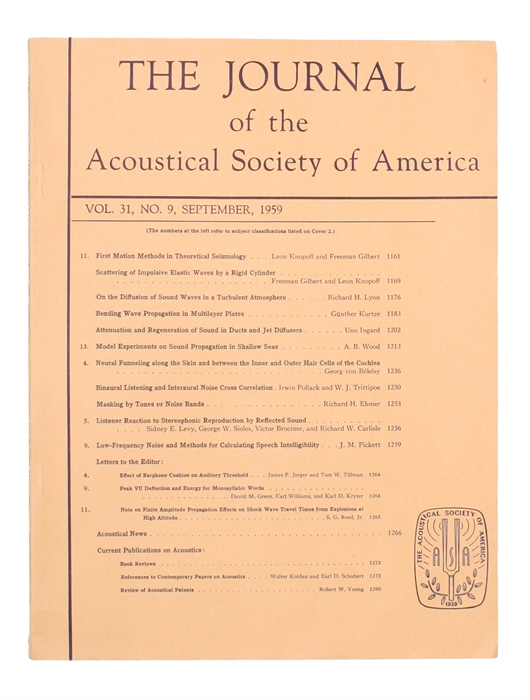THE ANTICIPATION OF THE MP3
EHMER, RICHARD H.
Masking by Tones vs Noise Bands.
Pennsylvania, The American Institute of Physics for the Acoustical Society of America, 1959. 4to. In the original yellow printed wrappers. In "The Journal of the Acoustical Society of America", Vol. 31, No. 9, September, 1959. Pp. 1253-56. [Entire volume: xii, 1161-1296 pp]. A fine and clean copy.
First edition of the important paper in which Ehmer described a complete set of auditory curves, which are regarded as the earliest contribution to the later development of digital audio files, MP3, today used in all iPods and digital music players.
The MP3 algorithm takes advantage of a perceptual limitation of human hearing called auditory masking, as introduced in the present paper.
Moving Picture Experts Group (hence the names: MPEG-1 or MPEG-2 Audio Layer 3 (or III), more commenly referred to as MP3), began development of the digital audio system "1 Audio Layer 3" in 1959, when Richard Ehmer first came up with the idea of auditory masking. It was, however, not until 1989, when Oscar Borello at the University of Buenos Aires, developed the first fully working device to play digital audio files, that it became a reality.
The first personal MP3 player was released in September 1995 and when Nullsoft's audio player Winamp came in 1997 its popularity increased tenfold.
The MP3-file is probably the most disputed and infamous - in the eyes of large record labels - computer related development ever released. The MP3 made it easy to exchange music, legal as well as illegal; major record companies started arguing that free sharing of music caused fewer sales, and they initiated lawsuits, the most famous being Napster.
To this day the MP3-file is probably the most used and exchanged file in the entire history of the electronic computer.
Order-nr.: 43219

